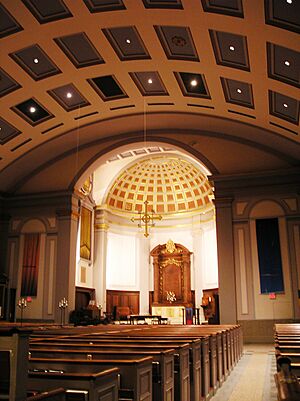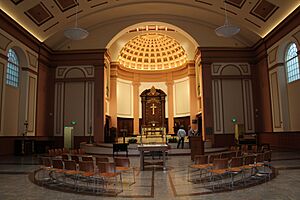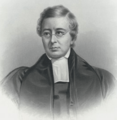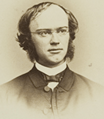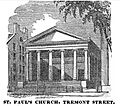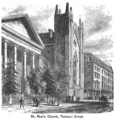Cathedral Church of St. Paul (Boston) facts for kids
Quick facts for kids St. Paul's Church |
|
|---|---|
| Cathedral Church of St. Paul | |
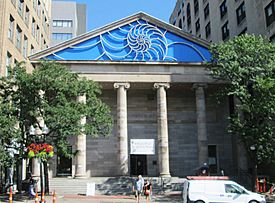 |
|
| 42°21′21″N 71°3′44.84″W / 42.35583°N 71.0624556°W | |
| Location | 138 Tremont Street Boston, Massachusetts |
| Country | United States |
| Denomination | Episcopal |
| Architecture | |
| Architect(s) | Alexander Parris Solomon Willard |
| Style | Greek Revival |
| Completed | 1819 |
| Administration | |
| Deanery | Boston Harbor |
| Diocese | Massachusetts |
| Province | New England |
| District | Central |
The Cathedral Church of St. Paul in Boston is a very old and important church. It serves as the main church for the Episcopal Diocese of Massachusetts. You can find it at 138 Tremont Street in Boston, right across from Boston Common.
This beautiful church was designed by Alexander Parris and Solomon Willard. It was finished in 1819. St. Paul's was the very first church in New England built in the Greek Revival style. Because of its special design, it was named a National Historic Landmark in 1970. In 2018, Amy E. McCreath became the ninth and first female dean of the Cathedral Church of St. Paul.
Contents
A Look Back: The 1800s
St. Paul's Church was started in 1819. At that time, Boston already had two other Episcopal churches. These older churches, Old North Church and Trinity Church, were founded before the American Revolution. They were part of the Church of England.
The people who started St. Paul's wanted a church that felt completely American. They wanted it to be new and different. It was also the first building in Boston to use the Greek Revival style, which was very modern for its time.
Who Designed It?
The architects for St. Paul's were Alexander Parris and Solomon Willard. Alexander Parris is famous for designing Quincy Market. Solomon Willard is well-known for creating the Bunker Hill Monument.
The outside of the church is made of strong granite and sandstone. It looks much the same today as it did when it was built. There was a plan to put a carving of St. Paul preaching in the triangular space above the entrance, but it was never completed. A famous American, Daniel Webster, was one of the people who attended this church.
The 1900s and Beyond
In 1912, St. Paul's became the main cathedral for the diocese. This happened because the area around the church had changed. It became less of a neighborhood where people lived and more of a business district.
When it became a cathedral, the church had some big changes inside. The area around the altar, called the chancel, was updated. It got a fancy half-dome ceiling, beautifully carved wooden screens, and new choir benches. The architect for these changes was Ralph Adams Cram. He was known for designing many famous Gothic churches, like the Cathedral of St. John the Divine in New York City.
Music at the Cathedral
For about 100 years, from the 1880s to 1980, St. Paul's had a special choir. This choir was made up of men and boys. They sang hymns and other songs during Sunday services. Their first choirmaster was Warren Andrew Locke, who also worked at Harvard University. The last organist and choirmaster for this choir was Thomas Murray, who later became a professor at Yale University.
Church Design and Renovations
One interesting feature inside the cathedral is The Labyrinth. It's a special design on the floor that people can walk to help them think and meditate. This labyrinth was inspired by one found in Ravenna, Italy.
The stones used for the outside of St. Paul's Church came from other famous churches. Some stones came from St Paul's Cathedral in London, England. Others came from St. Botolph's in Boston, England.
In 2014, the cathedral began a big project to update its interior. These renovations were finished in the fall of 2015. During this time, skylights were added to the ceiling to bring in more natural light. A curving ramp around the altar was made easier to use for everyone. Stained glass windows and other parts of the chapel were also updated. One of the biggest changes was removing the traditional church pews. This was done so that worship could be focused around the altar, which was moved to the center of the space.
Leaders of the Cathedral
The Cathedral Church of St. Paul has had many important leaders over the years. These leaders are called rectors or deans. Here are some of the people who have served the church:
- Samuel Farmar Jarvis, 1820–1825
- Alonzo Potter, 1826–1831
- John S. Stone, 1832–1841
- Alexander Vinton, 1842–1858
- William Nicholson, around 1860s
- Treadwell Walden, 1873
- William Newton, 1877–1882
- Frederick Courtney, 1882
- John Summerfield Lindsey, 1889
- Thomas Augustus Jaggar, 1906
- William Faulkerner, 1908
- Edmund Swett Rousmaniere, 1909 (became the first Dean in 1912)
- Philemon Fowler Sturges, 1926 (second Dean)
- Edwin Jan Van Etten, 1940 (third Dean)
- Charles Henry Buck, 1953 (fourth Dean)
- John Bowen Coburn, 1980 (fifth Dean)
- Thomas Kennedy, 1985 (sixth Dean)
- David Elliot Johnson, 1986 (seventh Dean)
- Jep Streit, 1996 (eighth Dean)
- Amy E. McCreath, 2018 (ninth and first female Dean)
Images for kids
See also


